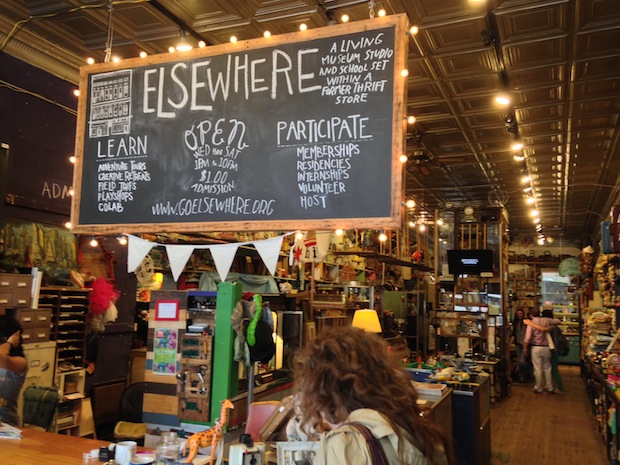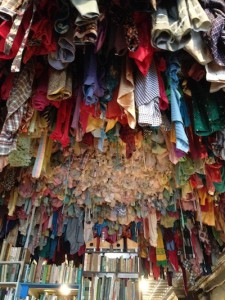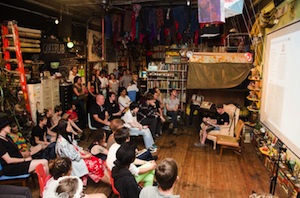Elsewhere
606 South Elm Street, Greensboro, NC 27406
What’s on view: An old three-story thrift store in the town of Greensboro, North Carolina, once owned by a woman named Sylvia Gray and converted by her grandson, George Scheer and partner Stephanie Sherman into an artist residency. The place is overflowing with old toys, fabrics, clothing, books, etc, which artists reconfigure into various projects—but no object leaves the building. This method has produced everything from a tornado made of dolls to World War II research projects to Elsewhere’s own TV show.
Paddy Johnson: Any art critic will tell you that having to spend hundreds of hours attending art fairs and biennials can make you suspicious of the communal good art is supposed to offer. As a critic you’re taught to seek the tangible and at a fair, where all “intangible goods” come with a price tag, the whole concept begins to feel like a marketing ploy. Did anyone else get the feeling that “Al’s Grand Hotel,” Allen Ruppersberg’s conceptual art hotel of 1971, reconstructed for Frieze New York, was just a bit of “value added” for the fair? Thanks to Frieze’s non-profit foundation, the fair didn’t have to pay a thing for the attraction.
Now that’s wildly cynical (people at Frieze actually care about art), but it’s also a good case for why it’s essential to break out of the art fair circuit. If you don’t, you’ll never fully understand the energy that made Ruppersberg’s hotel so special in its first iteration—the personalized care and art experience were all but sucked out for Frieze—or the creative life that permeates Elsewhere in Greensboro, North Carolina.
I never experienced the first iteration of “Al’s Grand Hotel,” but I have been to Elsewhere, and I can’t remember the last time I saw a project that excited me as much. Even just its size seems incredible; three stories of artist space filled with materials and artists. Coming from New York, where real estate sells for as much as $6,000 per square foot, you feel like you’re bathing in riches.
The whole place feels like a living artwork. Pieces I’d seen and loved when I was there last year—a ladder used as a shelving unit and firetruck hat stand—were transformed into other things I loved: an Elsewhere Community Broadcast center that used a CRT TV with the screen removed as a set for constantly arranged canvases. Others pieces were more permanent: a wall-mounted musical instrument made of piano strings, drums, cymbals, et cetera, and played with bouncy balls you throw at the piece had been there since the early aughts. Another piece, a tornado of dolls, hangs off the peeling roof of a room in the upstairs, and has been there for years. It’s creepy because dolls are creepy, but also because if you look at for a while the piece starts to look like a unique form of Elsewhere mold.
Corinna Kirsch: Okay, I believe that all of us have really great things to say about Elsewhere, so I’m going to play devil’s advocate for a second—and then I’ll get into what’s singular about Elsewhere, and why I think we need more spaces like them, places that are into art as a playful proposition, not just about objects.
First off, Elsewhere isn’t going to charm everyone. Walking into the shop, I kinda dreaded the thought that this might be a nostalgia project: the toys were all made before I was born, works are tagged with old-fashioned paper labels, and there was a sewing station. Generally, it looks like a thrift shop, like some Zooey Deschanel’s Salvation Army dream. It was hard to find something contemporary in this pre-digital landscape. Of course, that’s only a first impression. Later on I asked George about whether there’s any aspect of nostalgia, but he quickly dismissed that notion. Elsewhere just leaves his grandmother’s shop the way it was when she passed away and the artists create their own projects from that. Nobody can take away from the store, and nobody can add anything to it. So if the Elsewhere model were proposed elsewhere (ha), there could certainly be a more contemporary update. It’s just about taking unused space and doing something with it.
Then, still playing devil’s advocate, there’s the artist projects that have been installed throughout Elsewhere. Residents come in, and within just a few days of their arrival, they’re supposed to come up with an idea for what they want to do in the space. Artists are allowed nearly total freedom, but the permanent installations we saw didn’t necessarily point to that; we saw a fair number of creepy baby dolls used in the art. So that was a bit confusing, that given that freedom, we saw some fairly generic output. But whatever: Products aren’t the point of Elsewhere.
Paddy: I don’t remember the dolls anywhere other than in the baby doll tornado. I mean, I had the same thought when I looked at that piece, but I stopped worrying about it, because I couldn’t imagine a doll that wasn’t creepy or cliche in an art context. I suppose there’s always a bright side for the doll art-haters amongst us; most of them were used up in that one piece.
Corinna: There were at least two creepy “doll” pieces! One used up mannequins and the other used baby dolls.
Paddy: That was a room full of legs that hung from the ceiling—I thought that was an effective use of those mannequins! Still, this leads me to a similar issue that I think we might both be getting at: a large number of the projects used the same aesthetic device—mass amounts of a particular material. That’s probably a result of the source material artists are working with, which would repeat themselves—the shirt canopy hanging from the ceiling on the first floor was beautiful transformation of that clothing, but I was less convinced by the confetti room. Somehow an old party room feels a little more generic.
Corinna: Yes, I see where you were coming from; accumulation seemed to be a model for many. I guess that’s the first thing you’d think of when you see so much surplus!
Whitney: Paddy, I love this place for all the same reasons. You’d mentioned that on your first trip, people were just hanging out in elegant thrift store costumes because they were just “living a creative life.” I know I complain about this to no end, but it’s really the kind of space and freedom that’s a) necessary for creativity to survive and b) is a lot harder in New York where apartments are small, and everything costs money to do. When we came back to Elsewhere after dinner, artists were singing karaoke on the front porch, for everybody who might pass in the street. I remember fun.
And George kept mentioning this throughout the tour, but the freedom afforded by all the space and extra junk (or hoardiculture, as the website puts it) can be considered a reflection of economic conditions. It’s amazing how much material abundance could be accumulated in one lifetime, and comes with 20th century hopes of endless expansion, and the attitude that quantity equals quality. People are reevaluating those ideas now. That’s why I don’t mind the dated references in old objects, like you mentioned, Corinna; I just thought about it as a capsule to look at the conditions that shaped the world into how it is today, to infinitely pick apart its structures and put them back together. Subject matter is truly limitless.
And yes, some of the artworks were stronger than others, but I didn’t mind that so much either. Like you said, products aren’t really the point (like, it would seem silly for an individual artist to put an MFA thesis project in here). It’s all temporary, and nothing’s meant to stand on its own outside the space anyway, so it felt like more of a group testing ground than a finished book.
Paddy: And that’s not just because thesis projects are supposed to be finished works, but because so many of them aspire for a place in the commercial gallery system. There’s nothing wrong with that, but it’s refreshing to visit a residency that isn’t defined by those values.
Whitney: Yes.
Corinna: Okay, I think we can all agree that the criticisms we have for Elsewhere aren’t that strong and now I can come out and say that I love Elsewhere. I was really impressed with two projects, the make-music room, where you’d throw a bouncy ball at a wall of instruments and hope to get something pleasing out of your chance throw, and one of the older rooms, which organized the store’s entire army surplus clothing and other ephemera into folded stacks of pants, et cetera.
And Elsewhere has a costume closet, so you can dress up for absolutely no reason whatsoever. Here I am, dressed up as a Peter Pan with Old West-style fringe:








Comments on this entry are closed.